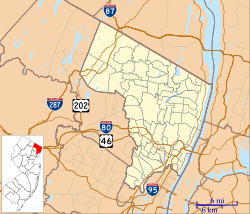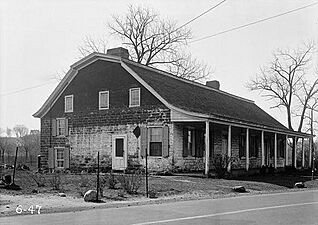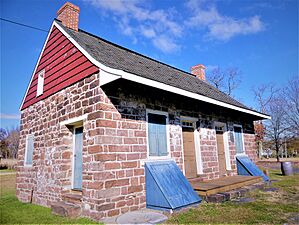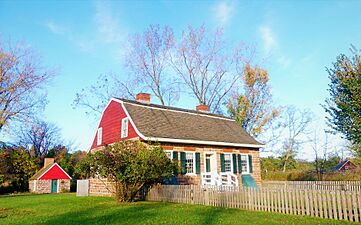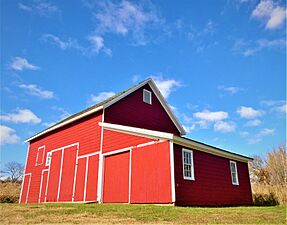Steuben House facts for kids
|
Steuben Estate Complex
Ackerman–Zabriskie–Steuben House |
|
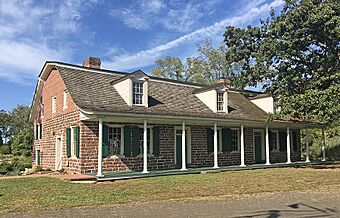
Steuben House in 2019
|
|
| Location | New Bridge Road, Main Street and Hackensack River River Edge, New Jersey |
|---|---|
| Area | 6 acres (2.4 ha) |
| Built | 1752 |
| Architectural style | Colonial, Dutch Colonial |
| MPS | Early Stone Houses of Bergen County |
| NRHP reference No. | 70000381 (original) 80004403 (increase 1) 83001457 (increase 2) |
Quick facts for kids Significant dates |
|
| Added to NRHP | December 18, 1970 |
| Designated HD | December 9, 1980 |
The Steuben House is a famous example of "Bergen Dutch" sandstone architecture. It is located at New Bridge Landing on the Hackensack River in River Edge, New Jersey.
This house was taken from its owner, Jan Zabriskie, who supported the British during the American Revolutionary War. It served as a military headquarters for much of the war. General George Washington even used it as his headquarters from September 4 to 17, 1780.
After the war, the house was given to Major General Baron von Steuben. He was a hero who helped train the American army. He lived in the house from 1783 to 1788.
The Steuben House was added to the National Register of Historic Places on December 18, 1970. This was because of its important architecture and military history. The Steuben Estate Complex is a 6-acre historic area. It was listed on December 9, 1980, for its importance in architecture, exploration, and invention. This area includes the Steuben House and three other historic buildings. These buildings were moved there from other places.
The house is also known as the Ackerman–Zabriskie–Steuben House. It was listed as part of the "Early Stone Houses of Bergen County" on January 10, 1983. This was for its importance in architecture and early settlement. The Bergen County Historical Society opens the New Jersey State Historic site and other old houses to the public for special events.
Contents
The Steuben House: A Look Back in Time
The Steuben House has always been seen as an important landmark from the American Revolution. Its design and old furniture show us about the "Bergen Dutch" people. This was a farming community whose language and culture mixed ideas from Dutch, African, German, English, French, Scottish, and Scandinavian settlers.
Early Days and the First Owners
The area was first called Aschatking, meaning "where the river narrows." In 1682, a Swedish settler named Cornelius Mattyse bought 420 acres here. This land was where Tantaqua's Creek met the Hackensack River.
This spot was known as Tantaqua's Plain, named after a local Native American leader. In 1695, David Ackerman bought the land. His son, Johannes Ackerman, built a house there in 1713 when he married Jannetje Lozier.
The Tidal Mill and New Bridge
A special mill was built on the Hackensack River. This was a "tidal gristmill," which used the power of the tides. High tide water was trapped in a pond by a dam. When the tide went out in the river, the water from the pond was slowly let out. This water turned a waterwheel, grinding grain.
Boats called sloops could pull up next to the mill at New Bridge Landing. In 1744, a road was planned to this spot. A "New Bridge" was built there, which is now Main Street in River Edge.
The Zabriskie Family and House Expansion
Jan and Annetje Zabriskie bought the mill and farm in 1745. This was soon after the first draw-bridge was built at the narrow part of the Hackensack River. This wooden bridge was called "New Bridge" to tell it apart from an older bridge upstream.
In 1752, Jan Zabriskie built the oldest part of what is now the Steuben House. Its walls were made from sandstone blocks. The front of the house had carefully cut stones, while the other sides used rougher stones.
The Zabriskie family became rich from more trade during the French and Indian War (1756–1763). Around 1765, they made their house twice as big. It grew from five rooms to twelve rooms, with seven fireplaces. They also added a stylish gambrel roof. This type of roof has four slopes instead of two, giving more space inside.
New Bridge Landing became a busy center for trade. Iron from nearby mountains was brought here by ox-carts. It was then loaded onto sloops, some as big as 50 tons, and shipped to markets. Flour and animal feed were also shipped from the mill. All kinds of goods arrived from boats returning from the city. This location was important because it was the closest river crossing to Newark Bay until 1790. Travelers and wagons going to and from New York City crossed the river here.
The Steuben House During the Revolutionary War
The Steuben House was used as a military headquarters for much of the American Revolutionary War. General Washington stayed here in September 1780 for 14 days. This was when the Continental Army had nearly 14,000 soldiers camped nearby.
New Bridge Landing was often a place of fighting. Here are some important events that happened there:
- November 20, 1776: British and Hessian troops tried to trap American soldiers at Fort Lee. General Washington led his troops across the Hackensack River at New Bridge, escaping safely. This event was seen by Thomas Paine, who wrote his famous words, "THESE are the times that try men's souls."
- November 21, 1776: British troops attacked the American rear guard and took the New Bridge. American engineers were trying to take it apart.
- August 18, 1779: Major Henry Lee led American troops from New Bridge to attack British defenses at Paulus Hook.
- March 23, 1780: American militia and soldiers attacked British troops at New Bridge. This happened as the British were retreating from Hackensack.
- September 4–17, 1780: General Washington made the Zabriskie-Steuben House his headquarters. This was during a large encampment of the Continental Army.
After the War: Baron von Steuben's Home
The State of New Jersey took the stone mansion from Jan Zabriskie in 1781 because he was a Loyalist (someone who supported the British). The New Jersey Legislature gave the Zabriskie estate at New Bridge to Major General Baron von Steuben on December 23, 1783. He was the Inspector General of the Continental Army.
Steuben had to live in the house and not rent it out. He had to keep a bed and a servant there and visit regularly. His assistant, Captain Benjamin Walker, lived there. He managed the mill and river dock. Captain Walker bought the estate for Steuben in 1786. This is the only 18th-century building that Steuben owned that is still standing.
Steuben fixed up the house, which had been damaged in the war. In 1788, he sold it back to the Zabriskie family, to Jan, the Loyalist's son. John J. Zabriskie, Jan's grandson, died in 1793 trying to free the mill's waterwheel. Andrew Zabriskie, a cousin, bought the Steuben House in 1815. His family owned the property until 1909.
Preserving History: The Steuben House Today
The Steuben House Commission was created in 1926 to buy Baron Steuben's home. The State took ownership of the historic mansion and 1 acre of land for $9,000 on June 27, 1928. It was fixed up and opened as a museum in September 1939. The Bergen County Historical Society manages the museum.
The Society also bought more land around the house in 1944. In 1954, they convinced Bergen County to build a new highway bridge north of the site, instead of right next to it. The highway bridge opened in 1956. The old one-lane swing bridge from 1889 was closed to cars but is still open for people walking.
Historic New Bridge Landing Park
The Steuben House, the bridge, the old mill location, and the wharf are all part of the main area of Historic New Bridge Landing. Three more historic buildings were moved to the nearby property of the Bergen County Historical Society. This is a private, non-profit group run by volunteers.
- The Demarest House was moved here from New Milford in 1956.
- The Westervelt-Thomas Barn was moved from Washington Township in 1958.
- The County of Bergen moved the Campbell-Christie House here in 1977.
The Society also built a working copy of a Bergen Dutch Out-Kitchen in 1991 and an outhouse in 2009.
The Historic New Bridge Landing Park Commission was created in 1995. Its job is to plan and carry out all activities at Historic New Bridge Landing Park. In 2004, this park was named one of three new urban state parks.
Gallery
-
Campbell-Christie House with Out-Kitchen
2007 Flood Impact
The Steuben House did not suffer much lasting damage during the big storm in April 2007.
See also
- New Jersey during the American Revolution
- List of Washington's Headquarters during the Revolutionary War
- National Register of Historic Places listings in Bergen County, New Jersey


